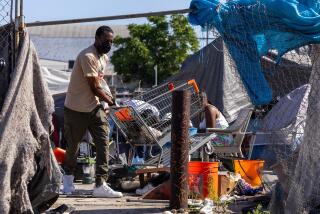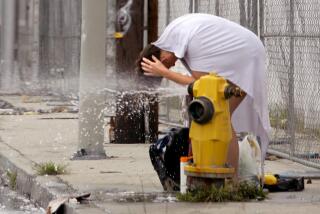County Predicts 300 Cases This Year : Rising TB Rate Putting Homeless at Risk
- Share via
Their living conditions are substandard, their nutritional habits are poor. And when they get sick, they lack proper medical care.
For those reasons, Orange County’s homeless are at high risk for developing tuberculosis, a communicable disease that is on the rise.
Last year, 284 cases of TB were reported in Orange County; by the end of the year, county health officials estimate, it will hit at least 300.
“Their lack of regular medical care and the general depressed conditions they’re living under are the kinds of conditions that are going to put the homeless in general poor health and make them more susceptible to someone who has an active case of TB,” said Harvey Shields, executive director of the American Lung Assn. of Orange County.
At the Orange County Health Care Agency office in Santa Ana, which provides daily TB skin testing, “we are sporadically seeing people we can identify as homeless in the clinic,” said Sharon Petrillo, program manager for TB control and refugee health at the agency.
“As far as the homeless, we need to get a handle on what our problem is here.”
To help determine how widespread TB is among the county’s homeless, the agency will conduct free TB skin testing from 11:30 a.m. to 1:30 p.m. Monday at the Homeless Drop-in Center at the Southwest Community Center, 1601 W. 2nd St., Santa Ana.
The TB screening marks the start of TB Awareness Week, an educational campaign sponsored by the American Lung Assn. of Orange County and the Orange County Health Care Agency.
In 1986, 22,575 cases of TB were reported in the United States, an increase of 374 cases from the previous year. The 1.7% increase “represented the first substantial rise in TB in the last 30 years,” Petrillo said.
Petrillo said the national Centers for Disease Control in Atlanta believes the increase is primarily from AIDS patients, who have compromised immune systems, and the homeless. Immigrants are also bringing the disease with them, Shields said.
Petrillo said people born in the United States generally are at a lower risk for developing TB because of better living conditions and available medical care.
“And the U.S. has a lower incidence of TB, so there’s less chance of exposure,” she said.
The disease is caught by breathing TB germs that have been coughed or sneezed into the air by an infected person. Unlike a cold or flu, however, TB is not easily spread. Frequent and prolonged exposure is necessary for transmission to occur.
Petrillo said symptoms can be vague, such as a mild cough or tiredness, and then progress to night sweats and evening fevers and eventually weight loss and coughing up of blood.
Crowded living conditions such as those in a shelter make the homeless even more susceptible if they come in contact with someone with an active case of TB.
“If a person’s general health is less than optimum, your natural body defenses are not going to be able to fight it off,” Shields said. “People who may have an unknown active case of TB can pass it on to other people, and the people they pass it on (to) may have a lower level of health, so it’s a vicious circle.”
The TB test involves an injection into the top layer of the skin. The results of the test are not visible until two or three days later.
“The test will indicate whether there are any TB germs in the body,” Shields said. “If they test positive, it doesn’t mean they have an active case, but it means they have been infected.”
Shields said an infected person would be put on medication to help him from coming down with an active case and to keep him from infecting others.
Tuberculosis, Shields stressed, is curable.
More to Read
Sign up for Essential California
The most important California stories and recommendations in your inbox every morning.
You may occasionally receive promotional content from the Los Angeles Times.










